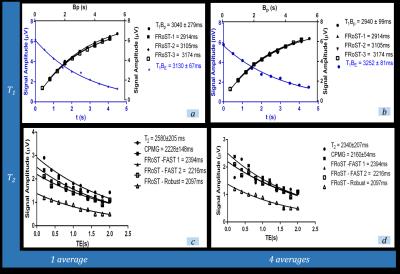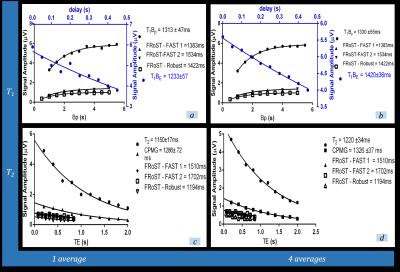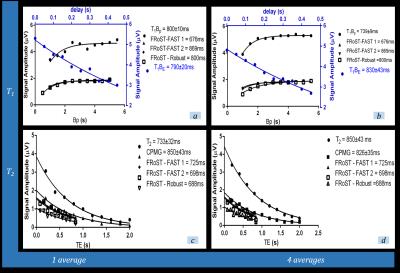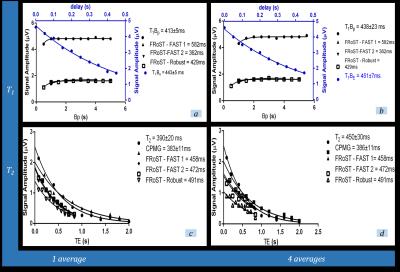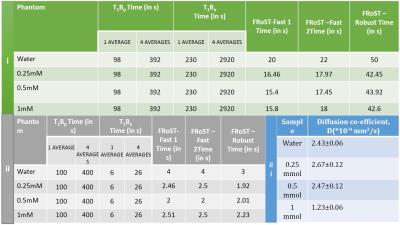4042
Fast, Robust and SimulTaneous (FRoST) relaxometry at polarizing field1Medical Imaging Research Centre, Dayananda Sagar Institutions, Bangalore, India
Synopsis
T1 and T2 measurements in polarizing field systems have long acquisition times due to the inclusion of a polarizer pulse. Current work demonstrates Fast, RObust and SimulTaneous relaxometry (‘FRoST’) measurements at Earth’s field on water and CuSO4 phantoms. FRoST creates a variation of the net magnetization through a series of CPMG acquisitions by varying the polarizing pulse (τp) to obtain simultaneous T1 and T2 weighting. T1 and T2 values obtained are similar to standard sequences and the acquisition time is reduced by 55%-84%.
Introduction
Cancer is the second leading cause of death in the United States1. MR studies of ex-vivo cancer tissues of breast, prostate and rat brain show that increased contrast (T1 weighted) between normal and cancerous tissues can be obtained at ultra-low fields2-4 as compared to high fields. Diffusion measurements using Pulsed Gradient Spin Echo (PGSE) sequence in polarised magnetic field has been widely used to characterize materials5.Polarizing field systems employ a polarizer pulse of 3 to 5 seconds long to increase the net magnetization. Variation of net magnetization is achieved by varying the strength of the polarization pulses. Hence, T1 and T2 measurements at Earth’s field have long acquisition times. Current work demonstrates a Fast, Robust and SimulTaneous T1 and T2 sequence called ‘FRoST’ using CPMG sequence on water and CuSO4 phantoms.Methods
All experiments were performed on an Earth’s field MRI system, Terranova (Magritek Gmbh, Germany). FRoST creates a variation of the net magnetization by varying the polarizing pulse (τp) through a series of CPMG acquisitions. CPMG was chosen for the implementation of FRoST due to its inherent acceleration capability by collecting multiple echoes in a single TR and hence requires reduced acquisition time for determination of T2. All experiments were carried out on a 500ml water phantom and CuSO4 phantoms of concentrations 0.25mM, 0.5mM and 1mM. One of the Fast schemes of FRoST termed as ‘FRoST-Fast 1’ employs variation of τp linearly from 1000ms to 4000ms with a step of 1000ms. Another fast scheme of FRoST termed as ‘FROST-Fast 2’ had τp chosen as 1000, 2000, 4000 and 5000ms to acquire exponentially increasing and saturation regions of the T1 relaxation curve. For robust measurements, τp was varied from 500ms to 5000ms with a step of 500ms. Minimum possible echo time of 200ms for water and 80ms for CuSO4 phantoms were for increased SNR and T weighting. The first signal intensity of every CPMG acquisition was curve fitted as a function of τp using the equation S=S0 (1- e –τp/T1) to obtain T1 and; T2 was obtained directly as a result of CPMG. The relaxometry measurements and their acquisition times were compared with standard T1 and T2 sequences like ‘T1Bp’, ‘T1Be’, ‘T2’ and ‘CPMG’. Diffusion mapping was also performed using PGSE sequence. The probe of the Terranova consists of a specific diffusion gradient coil with a field gradient per unit current of 2.38 (mT/m/A). The pulse width, δ, of the diffusion-weighting gradient was varied from 3 ms to 60 ms, in steps of 3. The polarisation period was 4000ms for a polarizing current of 6A. PGSE gradient coil produced a magnetic field gradient (G) of 4.76 (mT/m) for a maximum allowable current of 2 A. The distance between two gradient pulses, Δ, was 200 ms.Results
Figures 1-4 show the T1 and T2 obtained using standard sequences (macros) for T1 and T2 measurements in Terranova and those obtained using FRoST for 1 and 4 averages for water and CuSO4 phantoms. It can be observed that FRoST provides fast and robust relaxometry measurements that are similar to the standard macros available in Terranova. Table 1 shows the acquisition times for T1 and T2 measurements from standard sequences and FRoST. It can be seen that FRoSt provides accelerated and simultaneous relaxometry measurements in much lesser time as compared to standard sequences. It also shows the value of diffusion coefficient for water and CuSO4 phantoms at Earth’s field obtained by the PGSE experiment. Each diffusion coefficient is the mean value of 3 trials. The magnitude of the apparent diffusion coefficient tends to decrease with increase in the concentration of the CuSO4 solution, as expected.Discussion
The first echo of every TR over an entire scan is essentially T1 weighted and the echoes obtained in each acquisition are T2 weighted. The signal intensities from FRoST are however reduced due to effects of shorter τp. FRoST employs series of CPMG acquisitions which results in T2 values to be inherently averaged 4 times in the case of fast acquisitions and 10 times in the case of robust acquisitions.Conclusion
Increased averaging results in better T1 measurements in a time much lesser compared to 1 average acquisition of T1Bp and T1Be sequences. This would aid in rapid determination of T1 and T2 of dynamically changing biochemical reactions such as protein exchange reactions4. Variation of τp is analogous to variation of TR which enables application of FRoST to high field systems as well. Future work involves in application of FRoST and PGSE experiment to characterize tumours ex-vivo at Earth’s fieldAcknowledgements
Department of Science and Technology (DST). DST/TSG/NTS/2013/100References
1. Facts, C. (2016). Cancer Facts & Figures.
2. Lee, Seong-Joo, Jeong Hyun Shim, Kiwoong Kim, Seong-min Hwang, Kwon Kyu Yu, Sanghyun Lim, Jae Ho Han et al. "Relaxation Measurement of Ex-Vivo Breast Cancer Tissues at Ultralow Magnetic Fields." BioMed research international 2015 (2015).
3. Liao, Shu-Hsien, Kai-Wen Huang, Hong-Chang Yang, Chang-Te Yen, M. J. Chen, Hsin-Hsien Chen, Herng-Er Horng, and Shieh Yueh Yang. "Characterization of tumors using high-Tc superconducting quantum interference device-detected nuclear magnetic resonance and imaging." Applied Physics Letters 97, no. 26 (2010): 263701.
4. Forsén, Sture, and Ragnar A. Hoffman. "Study of moderately rapid chemical exchange reactions by means of nuclear magnetic double resonance." The Journal of Chemical Physics 39, no. 11 (1963): 2892-2901..
5. Callaghan, P. T., C. D. Eccles, and J. D. Seymour. "An earth’s field nuclear magnetic resonance apparatus suitable for pulsed gradient spin echo measurements of self-diffusion under Antarctic conditions." Review of scientific instruments 68, no. 11 (1997): 4263-4270.
Figures
